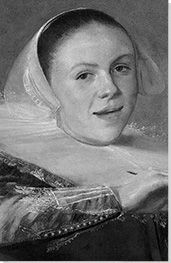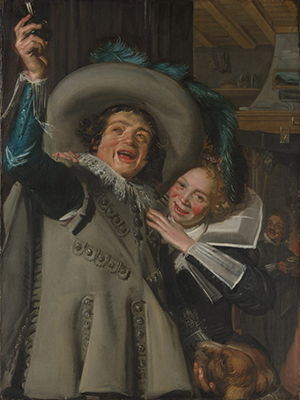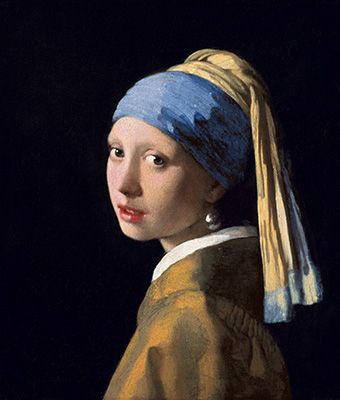Summary of Judith Leyster
Overlooked by art historians for centuries, Judith Leyster was a central figure in the Dutch Golden Age. A recognized master, her lively genre scenes built upon contemporary trends with their informality and technical mastery. In particular, she was known for upbeat, informal images of happy musicians and raucous groups. She was financially successful and respected by her peers, yet centuries of misattribution and neglect sidelined her legacy until more recent scholarship that focused on forgotten women artists.
Accomplishments
- Painting lively scenes of musicians and drinkers, Leyster specialized in capturing the leisures and entertainments of the Dutch Republic during the 17th century. Her relatable subjects and informal, but technically precise, style reveal an artist who was connected to international trends of Baroque painting, but added to them her independent vision and style.
- Leyster's jovial subjects appear to enjoy life, yet she also imbued these works with potential moralizing interpretations. This was common among Dutch Baroque painters, who sought alternatives to traditional religious subjects but still desired some larger symbolic meaning in their work. Leyster's paintings, however, tend to remain ambiguous and subtle, encouraging the viewers to draw their own conclusions.
- Forgotten by art history, Judith Leyster's legacy was recovered by feminist art historians who, beginning in the 1970s, began to question the absence of women from the history of art. Leyster's 17th-century success and subsequent erasure from history provides one important example of the many women who have been omitted from the artistic canon.
The Life of Judith Leyster
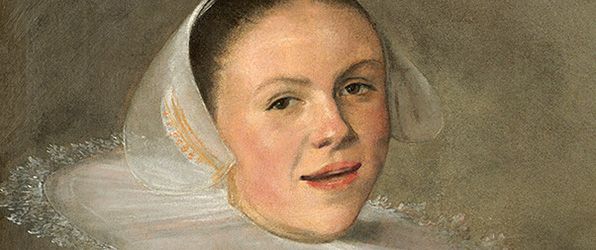
Judith Leyster’s 1633 Self Portrait is notable not just because X-rays have revealed that the figure on the background canvas was previously a girl, but because, as critic Peter Schjeldahl points out, the painted artist’s brush is playfully pointing at the replaced man’s crotch. He wrote: “The painting is a joy and, retroactively, a feminist icon.”
Important Art by Judith Leyster
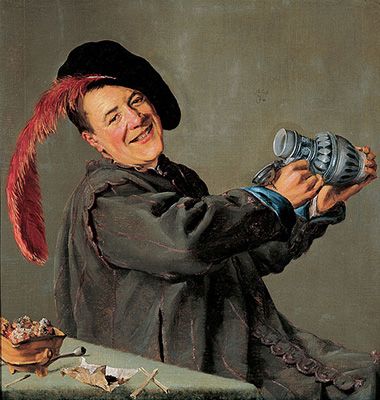
Jolly Toper
This painting is one of two earliest paintings attributed to Leyster. Here we see a good natured, ruddy-cheeked man, lifting up his beer jug as if to show us that his drink has just run out. He wears a greenish-blue long tunic, and the sloping angle of his beret suggests it may be in danger of falling off at any moment. On the table in front of him is a small pipe and some wrapped tobacco.
As art historian Cynthia Kortenhorst-Von Bogendorf Rupprath tells us, the subject of this painting was popularized by the group of artists known as the Utrecht Carravaggisiti before becoming a subject common among Haarlem painters from the 1620s. The subject's clear enjoyment of smoking and drinking might have suggested both the pleasures of life and the dangers of excess. Many paintings of this period included subtle moralizing messages on the transience of life and its indulgences. In adapting this common theme, Leyster clearly shows her knowledge of contemporaneous painterly trends and the desire to give them her own spin.
The idea of vice is contrasted to cheerful demeanour of the subject of the painting. The intricate detail of the sitter's face conveys a sense of the individuality and personality that recognizes his enjoyment of his evening (or afternoon) and predicts that he has not had his last drink.
Oil on canvas - Frans Hals Museum, Netherlands
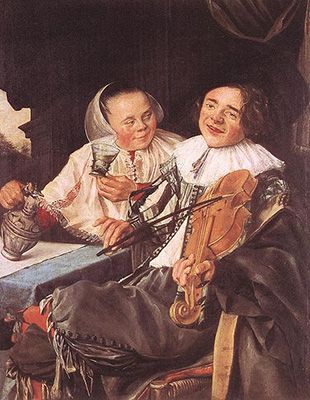
The Carousing Couple
This painting, which is also known as The Jolly Companions, depicts a couple as they drink and play music together. The man, wearing a wide black hat and large white ruff, leans back into his chair, his legs casually crossed, whilst in his hands he holds a violin aloft, as if about to play. His companion, nestled just behind him, holds an open beer jug and a glass of beer almost to her lips.
Like the Jolly Toper, Leyster depicts a moment of fun, and fills the picture with a lively energy. The facial expression on the young woman is particularly interesting: her cheeks flushed, she sends her half-smile towards her companion, looking at him fondly, or perhaps rather lasciviously. This could lead us to speculate on their relationship: are they a couple? Are they husband or wife? Or is another kind of transaction going on? Leyster leaves this unclear; she does however seem to suggest that this woman is sure of herself, and is not shy to show her own desire.
The man's direct look towards the viewer is open and relaxed, suggesting he hopes that the crowd enjoys his music as much as he does. Leyster often depicted musicians, either individually or in groups, creating her own interpretations on the theme of "the merry company" which often showed people of mixed genders drinking and having fun.
This painting was attributed to Frans Hals for hundreds of years due to a deliberate forgery. Leyster's signature was discovered in 1893.
Oil on panel - Department of Paintings of the Louvre, Paris
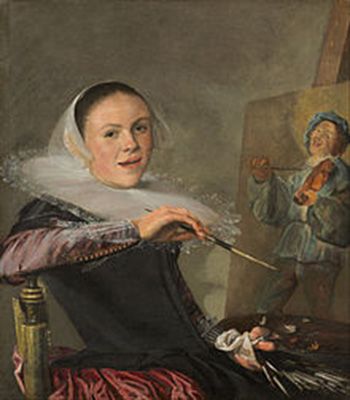
Self-portrait
This striking self-portrait appears to show Leyster as a woman fully at ease with herself and in command of her work and her career. She appears at her easel, taking a moment before finishing a painting of a young smiling violinist. She turns to face the viewer, as if we have interrupted her, yet she appears welcoming. The details convey her mastery: she holds eighteen brushes in her left hand along with a palette through which her thumb is looped; in her right hand she holds one brush, poised to make its mark. She wears a formal ruff and luxurious dress - which she is unlikely to have worn in real life while painting, but which speaks to her financial success and social status.
Author Dominic Smith writes of this image: "Her lips are parted as if she's about to speak. Her eyes are quick and vital. The brush in her right hand is held almost parallel to the violinist's bow in the painting she's working on at her easel, suggesting, perhaps, that music making and painting are deeply connected and ephemeral". Like her portraits of other people, this image also seems to celebrate joy and movement. But while her earlier paintings seem to show people relaxing and drinking, here Leyster shows joy in her work.
Oil on canvas - The National Gallery of Art, Washington DC
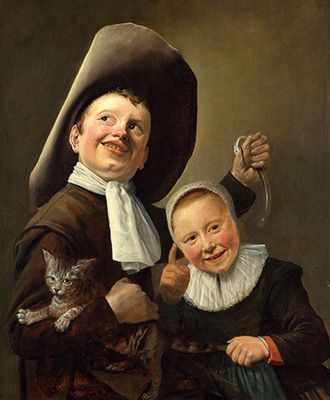
A Boy and a Girl with a Cat and an Eel
In this painting, Leyster depicts two cheeky looking children, a young boy and a young girl. The boy holds a small cat in the crook of his elbow, a white eel in the other arm. The little girl pulls on the tail of the cat while raising her finger to the viewer; she seems to be communicating something to us with her little smile. The cat looks rather disgruntled and its claws are bared, yet the pose of the young boy and the confidence of the little girl suggest that they are unaware that at any moment, chaos could break loose.
Children were often used at this time to illustrate bad or improper behaviour. Art historian Cynthia Kortenhorst-Von Bogendorf Rupprath suggests that this painting represents a Dutch proverb which translates as: "he who plays with the cat gets scratched, meaning he who looks for trouble gets it." The little girl's gesture seems to confirm this idea, as if she actively trying to get the viewer to contemplate this lesson. However, as with The Carousing Couple, there is something rather charming in their pink cheeks and smiles, even if they are behaving badly.
Oil on oak - The National Gallery, London
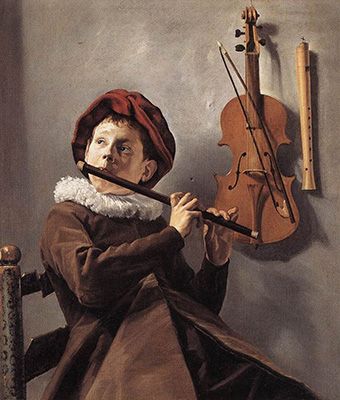
Young Flute Player
In this work, Leyster captures a solitary moment in which a young boy delicately plays a flute. He looks up and out of the frame, as if lost in concentration, or perhaps in the beautiful music itself. The precise placement of his fingers suggests a musician completely at ease with his instrument. At the same time, the composition of the painting is slightly unusual: against this plain interior, Leyster includes a violin and a recorder awkwardly displayed on the wall. The boy's posture is also slightly strange, as he leans back against what looks like a damaged chair. The boy's dreamy gaze suggests the power of music to transport the listener, a power not unlike the power of art.
There are many similarities between painting and music that run throughout Leyster's career. Art critic Peter Schjeldahl comments particularly on her virtuosic use of color here: "The work's finely modulated browns and grays are breathtaking. They affect like essences of the flute's sound - you practically hear them."
Oil on canvas - Nationalmuseum, Stockholm, Sweden
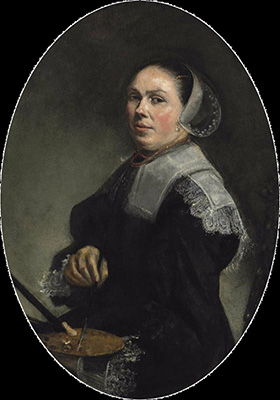
Self portrait of Judith Leyster
In this later self-portrait we see the older Leyster sitting down to work again with her paintbrushes. But, rather than the early picture, which contained many different paintbrushes and an example of her work in the frame, in this picture she is counterpoised against a blank, dark background, looking at the viewer at an almost downward angle. Though she still holds a palette in her hand, there only appears to be one color on there, and her easel is not visible. The focus is on the artist and not on the process of art-making itself.
Rather than the light color palette of the other self-portrait, and in contrast to her other work in general, Leyster here chooses a striking selection of blacks, whites and browns. The muted colors in this image along with the stern look upon Leyster's face seems to suggest that this is a woman who wants to communicate her seriousness to the viewer. Moreover, her upright position suggests the gravity of her craft: this is a painting that speaks of deep experience, a life lived in painting. Her dress, while similarly somber, still attests to her financial success and technical mastery of her craft with its delicate lace details.
Oil on canvas - Private Collection
Biography of Judith Leyster
Childhood and Education
Judith Jans Leyster was born in Haarlem, the Netherlands, in July 1609, the eighth of nine children. Her mother, Trijn Jaspers, was a weaver, and her father was a brewer who was born as Jan Willemsz, but had adopted the surname "Leyster," meaning "lodestar," in 1603.
Art historians speculate that Judith Leyster was trained in painting from a young age, perhaps studying with Frans Pietersz de Grebber, a well-respected Haarlem-based painter. Although there is no firm evidence, stylistic similarities between Leyster and the painter Frans Hals have led some scholars to believe that the two artists may have also worked together.

In 1629, Leyster's first known paintings, Serenade and Jolly Toper, are signed with her very particular monogram: JL accompanied by a star, suggesting the meaning of her name. This detail was critical to her legacy, helping her to avoid the fate of many women artists who have been forgotten by history. It provided a clear and unique signature that connected many paintings that had been historically attributed to her male colleagues.
In 1633, Leyster applied to join Haarlem's Guild of St. Luke's, an organisation for painters at the beginning of their careers. She was accepted into the guild and in that same year set up her own studio. She later took on three pupils, which led to a legal dispute with Hals; it appears that one of her students left Leyster's studio for Hals's without paying her for tuition. The two artists ended up going to court over this matter and her attempt to stand up to an older, more established painter suggests her bravery and assertiveness. As art historian James A. Welu notes: "Though it is dangerous to come to conclusions about someone's personality on the basis of a few legal documents related to business transactions, from all accounts, Leyster appears to have been a confident individual."
Middle Period
Between 1629 and 1635, Leyster seems to have worked steadily, producing much of the oeuvre we know today. She specialized in mixed-genre paintings, often including aspects of both portraiture and still life, and set in enclosed, indoor spaces. She followed the overarching style of many other painters from the time such as Frans Hals and his brother Dirck as well as Jan Steen. She was also very influenced by the Utrecht Caravaggisti, a group of painters who were themselves influenced by the work of Caravaggio. Though this scene only flourished for a few years, and ended in about 1630, Leyster would have certainly come into contact with some of the artists in this time.
However, this busy period was short lived: In June 1636, Leyster married the painter Jan Miese Molenaer in Haarlem. Molenaer was already a prolific artist, and was also a member of the Haarlem's Guild of St. Luke.
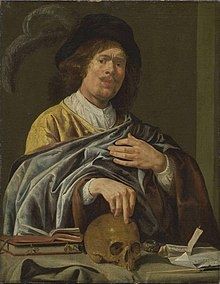
The couple moved to Amsterdam that same year, where they lived until 1648. The city promised increased work for the couple, as they knew various clients and art dealers there. Leyster had her first son in 1637, followed by another in 1639. She then had two daughters, Helena in 1643 and Eva in 1646. Leyster, had a son Constantijn in 1650. Sadly, only Helena and Constantijn survived into adulthood.
It seems that throughout their married life, Leyster and Molenaer worked together in their studio, which was probably a room in their family home. They seemed to have produced work that sold throughout their time together, as well as dealing on the art market in general.
Later years
With the comfortable income they seem to have made from their time in Amsterdam, in 1648 the family moved to Heemstede in North Holland. There are very limited works found from this time, leading many scholars to believe that Leyster had all but given up painting in this decade. It remains possible, however that paintings from this period are yet to be discovered or properly attributed to Leyster.
The couple seem to have been friends with many other painters from the Dutch Golden Age, including Jan Steen, the still life painter Jacque de Claeuw, and Dirck Bleker. Molenaer owned paintings by de Claeuw and they may have owned or sold paintings by the other artists too.
Leyster died around the beginning of February 1660. Her funeral was held on the 10th February, at Heemstede Church.
The Legacy of Judith Leyster
For more than 200 years after her death, Leyster's work was either attributed to her husband Molenaer or Frans Hals. This seems partly due to their similarity in style, but there also seems to have been deliberate forgery: in 1893, Leyster's signature was discovered underneath a forged signature of Hals on the 1630 painting called The Carousing Couple or The Jolly Companions.
With the rise of feminist studies of art history in the 1970s, scholars such as Linda Nochlin questioned the historical treatment of women artists. She named several artists including Artemisia Gentileschi and Rosa Bonheur as examples of maligned great artists whose careers had been repressed because of their gender. Nochlin's essay, "Why Have There Been No Great Women Artists?" sparked the reassessment of many female artists, including Leyster, whose work had largely been misattributed to her male colleagues.
Because Leyster's legacy was overlooked for centuries of art-making and history, it is difficult to say precisely who has been influenced by Leyster's work. It would seem that many of the artists who studied or cited Frans Hals or Molenaer as an influence may well be citing Leyster without realizing it. The realist paintings of Netherlandish painters such as Jacoobus van Looy and Isaac Iraels owe much to the style of Dutch Golden Age painting, where she was a leader among her contemporaries. Similarly, many key figures in both Impressionism and Realism studied the works of Dutch Golden Age painting as a means of considering the interaction between interior spaces and human life. Her impact is most likely larger than modern art historians can document.
Influences and Connections

-
![Caravaggio]() Caravaggio
Caravaggio - Hendrick ter Brugghen
- Gerrit van Honthorst
-
![Frans Hals]() Frans Hals
Frans Hals - Gerrit van Honthorst
- Hendrick ter Brugghen
- Dirck van Baburen
- Adam Elsheimer
- Genre painting
- Portraiture
- Still-life
- Utrecht Caravaggisti
- Jan Miese Molenaer
- Dirck Bleker
- Jan Steen
- Jacques de Claeuw
